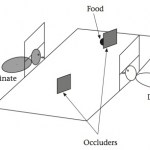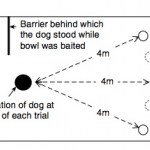Human-Animal Relationship
The LA Zoo wasn't always in as nice a facility as it is now. The "old" LA zoo was built in 1912 and was in use until 1965, when it moved to its current location just a couple miles away in a different area of Griffith Park. It's open to check out, and is adjacent to a picnic area. There are fenced off areas, but all the fences have giant people-sized holes in them. We thought of it more as: "enter at your own risk."
From the picnic area you can actually approach and walk around what used to be the public viewing area of the bear enclosure.
There is also some sort of old barn, with what I…
You've probably had a conversation that goes something like this:
Person A: "My dog is sooooo amazing!"
You: "I mean, dogs are awesome and all, but what's so amazing about this particular dog?"
Person A: "He just understands me. It's like he knows what I'm thinking and what I need."
You: "Do you think he's just maybe responding contingently do your overt displays of emotion?"
Person A: "Listen, man, I'm telling you: my dog can read my mind!"
No matter on which side of this sort of argument you tend to fall, the question of whether or not domestic dogs can read human minds is an interesting…
Given the recent elephant hunting scandal, I thought I'd repost this award-winning piece from the archives, on a very clever way to deter elephants from raiding human settlements. Much cleverer than shooting them. (Click on the archives icon for the original.)
What information is contained in the call of a mammal? Some calls might reflect the internal emotional state of the animal, like fear or anxiety, or they can refer to an external object, agent, or event, like the presence of a predator. Rhesus monkeys, lemurs, baboons, and guinea pigs, for example, will produce calls when separated from…
I was reading Christie's excellent post (and you should too) on GoDaddy CEO Bob Parsons' elephant killing incident (is it too early to be calling this #ElephantGate?)
Although I don't know quite enough about what is going on in Zimbabwe, I tend to err on the side of not intentionally killing elephants because - as I argued for the case of chimpanzees - they are very likely self-aware.
I wrote:
There is another important cognitive capacity that unites animals with high encephalization quotients (the ratio of brain to body size - I recommend going back to read my earlier post for the context…
A new piece by me today at the Scientific American Guest Blog, on some exciting news from the Jane Goodall Institute and Duke University:
Fifty years ago, in the summer of 1960 - the same year that a US satellite snapped the first photo of the Earth from space, the same year that the CERN particle accelerator became operational, the same year that the Beatles got their name - a 26-year-old Jane Goodall got on a plane in London and went for the first time to Gombe Stream Game Reserve, in Tanzania. She carried with her only a notebook and some old binoculars. Almost every day since the day…
I've got a new piece over at the Scientific American Guest Blog:
On Friday, March 11, Japan was rocked by an earthquake. People were displaced, a nuclear reactor was in trouble, and the world watched as a tsunami flooded Japan, threatened the islands of the Pacific, and ultimately hit the western coasts of North and South America. Chris Rowan pointed out that "Very little of the devastation resulting from this earthquake was from the initial shaking. This is partly because of Japan's stringent building codes. But mainly because any damage from the seismic waves that sent skyscrapers in Tokyo…
Watch this video and it might appear as if that beetle is being operated via remote control.
But wait. IT IS. The critter is a bit of a cyborg actually - part june bug, part computer. The man behind the zombie cyborg beetles is Michel Maharbiz, an associate professor in the Department of Electrical Engineering and Computer Science at the University of California, Berkeley. I met him last week at an event on the Science of Cyborgs organized by the Science and Entertainment Exchange.
When these arthropods are in the "pupa" stage, they get implanted with electrodes designed to stimulate the…
There is a small bit of land, only about a square kilometer, that has added a new wrinkle to the story of animal domestication. This bit of land located in Northern Jordan, just southeast of the Sea of Galilee near the banks of the Jordan River, is home to an archaeological site known as 'Uyun al-Hammam. One key feature of this site, excavated in 2005, is a burial ground containing the remains of at least eleven humans in eight different gravesites. The early humans were buried here sometime during the pre-Natufian period, or around 16,500 years ago.
Layout of the 'Uyun al-Hammam site, and…
Most dog owners think that their dogs can tell what they're thinking. Or at least, in some sense, they will insist that their pet pooches can sense their emotions, and respond accordingly.
Indeed, a man by the name of Karl Krall (say that three times fast) thought that there exist some sort of psychic connections between man and animal. And he thought he could prove it.
In this telepathy experiment between human and dog Karl Krall (on the right) tried to detect the thinking radiation he assumed to flow between the two. Krall was a rich dealer in diamonds who had founded his very own…
It's like a scene out of Romeo and Juliet, or perhaps the Rapunzel story. A wild bald eagle has taken up residence on a tree just adjacent to a bald eagle enclosure at the Orange County Zoo in Irvine, near Los Angeles. In fact, the wild bird has shown particular interest in the zoo's 6-year-old female bald eagle, Olivia.
According to LAist:
In fact, the pair have been chatting it up--well, squawking back and forth, as the Zoo manager explains, and seem to have struck up a friendship. Is it bald eagle love? Zookeepers aren't sure, since they don't know the sex of the visiting bird, though its…
If this doesn't tug on the heartstrings, at least a little bit, you may not be quite human.
As with yesterday's post, I don't know where this came from or who wrote it. If you do, please let me know so I can properly attribute it. It is again, a very "tall" image, so I've placed it behind the fold.
Click to enlarge.
In March 2000, Dr. Simon Chapman and colleagues from the University of Sydney published a paper in which they assessed the effectiveness of an educational intervention for the prevention of dog bites in children.
"Prevent-a-Bite" is an educational programme designed for primary school children. The programme aims to instill precautionary behaviour around dogs, assuming that this might reduce the incidence of attacks. A randomised controlled trial of the efficacy of the intervention was conducted in Australian children aged 7-8 years who were presented with an unsupervised opportunity to…
Last night, I was a guest of the National Geographic Channel at the historic Saban Theater in Beverly Hills for the United States premiere of Great Migrations, which airs internationally on Sunday, November 7.
Great Migrations is a 7-part TV "event," paired with an issue of National Geographic magazine, a set of kids' books, iPhone apps, and so forth. The mini-series, narrated by Alec Baldwin, focuses on the movements of animals across the earth in an effort to find food, to mate, and to survive. The first hour, which was screened for us, featured the migration of the monarch butterfly from…
Does Fido see the cup as half full? Is your dog pessimistic? Last time we saw headlines like these they were about a certain barnyard animal. Remember "Pampered pigs 'feel optimistic'"? I didn't like it then, and I don't like it now.
Roughly half of the population of dogs in the UK are likely to - at some point in their lives - exhibit "undesirable separation-related behavior (SRB)." These are things that sometimes happen when left alone, like barking, chewing up or otherwise destroying objects, and urinating (or worse!) inside the house. While some owners view these behaviors as fine and…
The National Institutes of Health announced that by 2011 it will transfer almost two hundred chimpanzees from the Alamogordo Primate Facility in New Mexico to a lab in San Antonio, Texas, lab for use in invasive research. In 1995, the NIH announced a moratorium on the breeding of chimps in federally-supported labs, and as a result, scientists have developed alternative ways to investigate diseases. But there are still viruses, such as hepatitis C and HIV, that other species simply can't contract. This fact, some argue, makes it prudent to subject chimps to this sort of biomedical testing.…
via Voice of America News blog:
Organizers of the Commonwealth Games in India say they will try to prevent wild monkeys from disrupting the event by deploying a team of larger, fiercer monkeys to scare off their smaller cousins.
Indian security officials put 10 langur monkeys and their handlers on duty Wednesday at several venues around New Delhi, the host city, to keep wild monkeys in check. More langurs will be deployed when the Commonwealth Games open on Sunday.
Some participating nations have expressed concern about the threat of wild monkeys, dogs and snakes attacking athletes and…
Your humble narrator finds himself sick with a cold, so here's a post from the archives.
There is considerable research on how children interact with other children and with adults, and how child development can be influenced by those interactions. But research on children's interactions with non-human animals seem to be limited. Given how ubiquitous pets are in the homes of children (at least, in WEIRD cultures), it is somewhat surprising that there hasn't been more work on the way pet ownership might affect child development.
According to the US Humane Society:
There are approximately 77…
At least one dog can be found in forty percent of US households, and forty percent of those owners allow their dogs to sleep on their beds. To put this in perspective, in a family with five children, two of them can be expected to become dog owners, and one of them will probably allow the dog to sleep on his or her bed. In an undergraduate lecture class of two hundred, eighty of those students come from homes with at least one pet dog. So as you might expect, dogs are a big business! In 2007, the pet industry was worth about $40 billion in the US, with dogs responsible for the largest share…
For today's dose of monday pet blogging, head on over to a piece that I wrote for Scientific American that went up today. I used the invitation as an opportunity to a dig a little deeper into the story of Belyaev and his domesticated silver foxes (I previously wrote about them, here and here)
Dogs are pretty smart. They can have huge vocabularies, they can infer meaning in the growls of other dogs, and they can effortlessly figure out if other dogs want to play or fight with them. But their intelligence might be limited to the social domain; indeed, while they outperform chimpanzees in social tasks, chimpanzees outperform them in many other tasks. And they might have developed their impressive social skills as merely an accident of natural and artificial selection.
Previous research has shown that dogs can use lots of different forms of human communicative signals to find food,…















